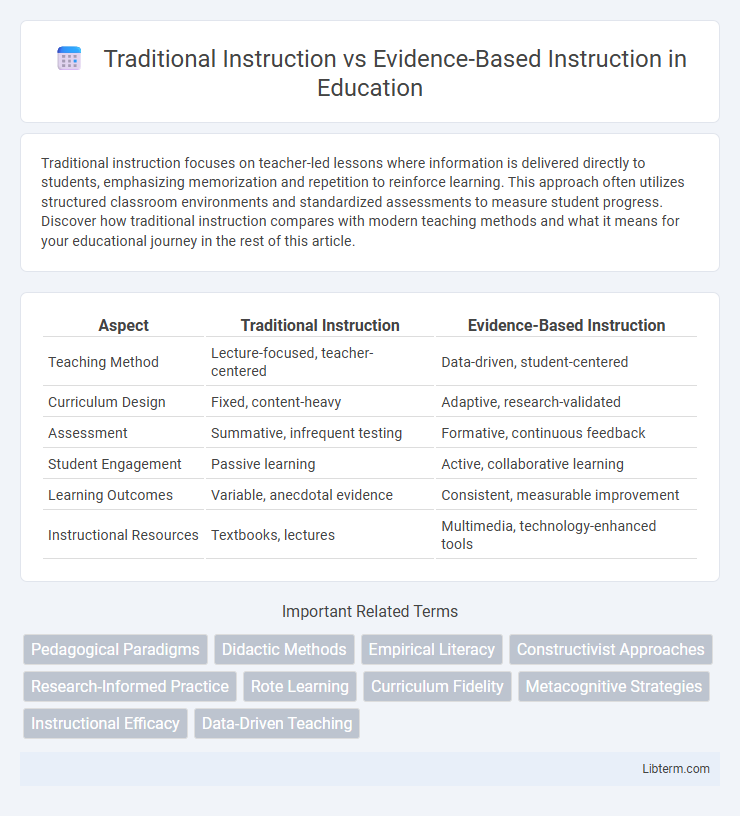Traditional instruction focuses on teacher-led lessons where information is delivered directly to students, emphasizing memorization and repetition to reinforce learning. This approach often utilizes structured classroom environments and standardized assessments to measure student progress. Discover how traditional instruction compares with modern teaching methods and what it means for your educational journey in the rest of this article.
Table of Comparison
| Aspect | Traditional Instruction | Evidence-Based Instruction |
|---|---|---|
| Teaching Method | Lecture-focused, teacher-centered | Data-driven, student-centered |
| Curriculum Design | Fixed, content-heavy | Adaptive, research-validated |
| Assessment | Summative, infrequent testing | Formative, continuous feedback |
| Student Engagement | Passive learning | Active, collaborative learning |
| Learning Outcomes | Variable, anecdotal evidence | Consistent, measurable improvement |
| Instructional Resources | Textbooks, lectures | Multimedia, technology-enhanced tools |
Understanding Traditional Instruction
Traditional instruction typically involves teacher-centered methods where lecturers deliver content through lectures, rote memorization, and repetitive practice, emphasizing standardized testing and curriculum adherence. This approach often prioritizes direct transmission of knowledge, with less focus on student engagement or adaptive learning strategies. Despite its long-standing use, traditional instruction faces criticism for limited encouragement of critical thinking and real-world application.
What Is Evidence-Based Instruction?
Evidence-based instruction integrates teaching methods that are supported by rigorous research and empirical evidence demonstrating their effectiveness in enhancing student learning outcomes. It relies on data-driven strategies, continuous assessment, and adaptation to meet diverse learner needs, contrasting traditional instruction that often depends on established practices without systematic validation. This approach prioritizes cognitive science, formative feedback, and proven pedagogical techniques to optimize educational impact.
Key Principles of Traditional Teaching Methods
Traditional instruction relies heavily on teacher-centered approaches, emphasizing direct instruction, rote memorization, and repetition to reinforce learning. Key principles include structured lesson plans, clear objectives, and a linear progression of content that prioritizes mastery of foundational skills. This method often uses drill-and-practice techniques and regular assessments to measure student retention and understanding.
Core Elements of Evidence-Based Strategies
Evidence-based instruction centers on core elements such as explicit teaching, systematic assessment, and data-driven decision making, which enhance student learning and engagement compared to traditional instruction methods. This approach integrates high-impact strategies like scaffolding, differentiated instruction, and frequent progress monitoring to tailor teaching to individual needs. Emphasizing evidence-based practices fosters measurable academic gains by promoting clarity, consistency, and targeted skill development in the classroom.
Comparing Learning Outcomes
Traditional instruction, often characterized by lecture-based teaching and rote memorization, typically results in lower retention rates and limited critical thinking skills compared to evidence-based instruction. Evidence-based instruction incorporates strategies such as spaced repetition, formative assessments, and active learning, which research shows enhance student engagement and knowledge retention significantly. Studies indicate that learners exposed to evidence-based methods outperform their peers in standardized tests and demonstrate improved problem-solving abilities across various subjects.
Student Engagement and Motivation
Traditional instruction often relies on passive learning methods, which can result in lower student engagement and decreased motivation. Evidence-based instruction employs active learning strategies, such as formative assessments and collaborative activities, that have been shown to enhance student participation and intrinsic motivation. Research from the Institute of Education Sciences highlights the positive impact of evidence-based practices on increasing student engagement and academic achievement.
Teacher Roles: Tradition vs. Evidence-Based
Traditional instruction positions teachers as authoritative knowledge transmitters who control the classroom and deliver content through lectures and rote memorization. Evidence-based instruction promotes teachers as facilitators and guides who actively engage students using data-driven strategies, formative assessments, and adaptive feedback to personalize learning. Research supports evidence-based approaches for improving student outcomes by fostering critical thinking, collaboration, and self-regulated learning.
Assessment and Feedback Approaches
Traditional instruction often relies on summative assessments and standardized tests to evaluate student performance, emphasizing final grades over ongoing improvement. Evidence-based instruction utilizes formative assessments and continuous feedback, allowing educators to tailor teaching strategies to individual learning needs. Research indicates that timely, specific feedback in evidence-based approaches significantly enhances student engagement and academic achievement compared to traditional methods.
Challenges in Transitioning to Evidence-Based Instruction
Transitioning from traditional instruction to evidence-based instruction presents challenges such as teacher resistance due to unfamiliarity with research-backed methods, limited access to professional development, and the need for ongoing support to implement data-driven practices effectively. Schools often face difficulties in aligning curriculum materials with evidence-based standards while also managing time constraints and balancing standardized testing demands. Overcoming these hurdles requires a strategic approach that includes investing in educator training, fostering a culture of continuous improvement, and utilizing technology to monitor instructional outcomes.
Building a Balanced Instructional Model
Building a balanced instructional model integrates traditional methods, such as direct lectures and memorization, with evidence-based strategies like formative assessments and differentiated instruction. This approach enhances student engagement and achievement by combining proven pedagogical practices grounded in cognitive science with time-tested classroom management techniques. Educators who blend these methodologies create adaptable learning environments that cater to diverse student needs while promoting critical thinking and retention.
Traditional Instruction Infographic

 libterm.com
libterm.com